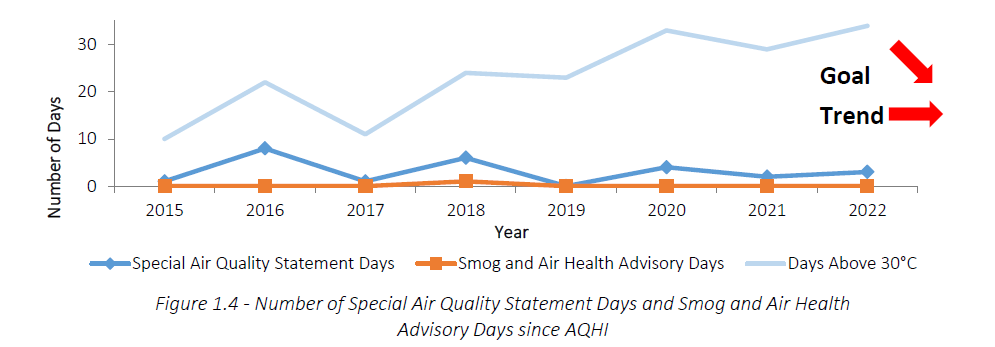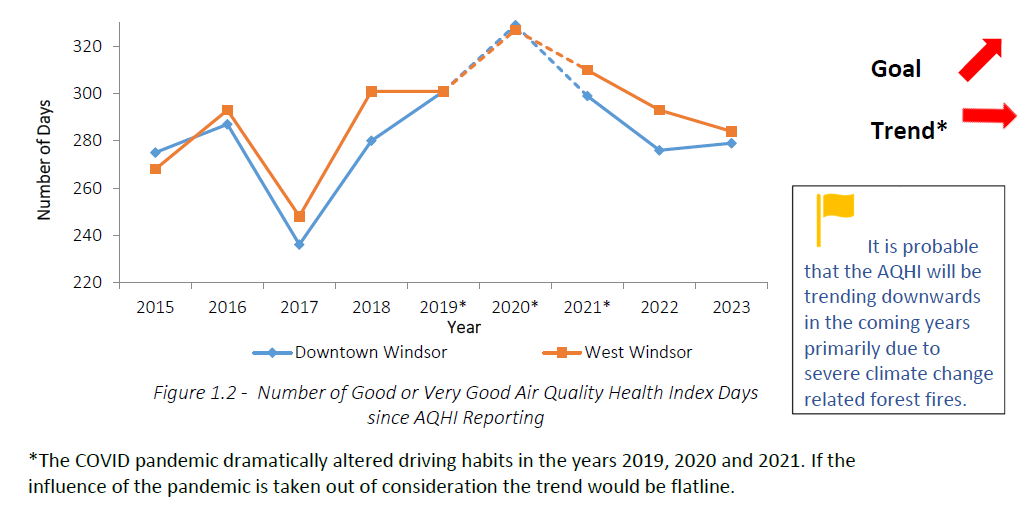Cross Border Air Pollution
Objective A1: Develop Strategies to Reduce Cross-Border Air Pollution
The following actions are needed to complete this objective:
- Advocate for Windsor’s local air quality issues at the regional, provincial and federal levels in the United States and Canada and with industry representatives
- Gather air quality baseline information for comparison purposes. Publish and track in the Report on the State of the Environment
- Identify partnerships with other agencies, governments and businesses
- Liaise with the Ministry of the Environment and Climate Change to increase environmental testing and compliance within the city
These indicators show the progress the City is making to achieve this objective:
- Number of Low Risk Air Quality Health Index Days
- Number of Special Air Quality Statement Days and Smog and Air Health Advisory Days
- Ground Level Ozone
Air Qual ity Health Index Indicator
ity Health Index Indicator
In June 2015, the Province of Ontario introduced the Air Quality Health Index (AQHI) to replace the Air Quality Index (AQI), which had been used since 2003.
For more information on these, check out the Air Quality Health Index fact sheet.
Good or Very Good Air Quality in Windsor (2015-2023)
Above graph shows a flatline trend in the number of good or very good air quality health index days since AQHI reporting.
Note: The COVID pandemic dramatically altered driving habits in the years 2019, 2020, and 2021. If the influence of the pandemic is taken out of consideration the trend would be flatline.
Special Air Quality Statement Days and Smog and Air Health Advisory Days since AQHI (2015-2022)

As seen in the graph above, the number of Special Air Quality Statement Days and Smog and Air Health Advisory Days have stayed low since 2015.
Ground Level Ozone Indicator
What is Ground Level Ozone?
Ozone (O3) is a colourless, odourless gas at ambient concentrations and is a major component of smog. It irritates the respiratory tract and eyes. Exposure to high levels of ozone results in chest tightness, coughing and wheezing. For more information on this, please see the Ground Level Ozone info sheet.
How are we doing?
The Ontario 1-hour AAQC (Ambient Air Quality Criteria) for ozone is 80 ppb.
Periods of 1-Hour Exceedances of Ground Level Ozone (2005-2022)

As seen in the graph above, the number of one-hour exceedances of acceptable ground level ozone concentrations, as set by the Ministry of Environment, Conservation & Parks (MECP), has declined.
For more information on Environmental Initiatives
Phone: For general inquiries, call 311. For detailed inquiries, call 519-253-7111 ext. 6127.
Email: emp@citywindsor.ca

